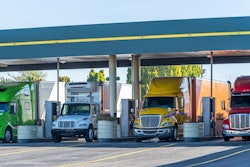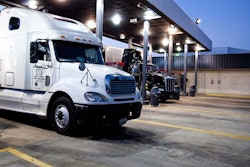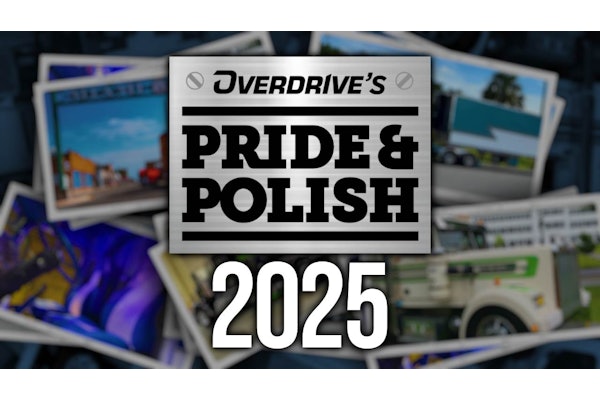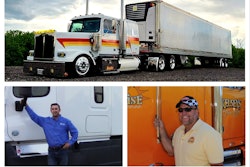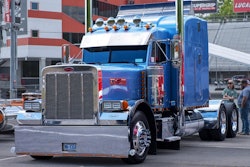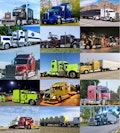It’s still possible to track an owner-operator business with paper and pencil. But with improvements in consumer technology, owner-operator apps and software, as well as steadily dropping prices, tracking your business electronically makes more sense than ever.
You can outfit yourself with a laptop or tablet equipped for wireless internet access and software designed to manage your business for well under $1,000. You can find a smartphone for little initial cost that can perform many of the functions that were once the sole domain of an internet-connected computer, and it doesn’t require a truck stop Wi-Fi subscription.
Some owner-operators use a tablet to have some of the advantages of a smartphone but with more of the feel and functionality of a laptop. The savings from managing your business, as well as revenue boosts using sophisticated services such as online and/or on-demand load matching, will net a speedy return on your investment.
Hardware considerations
Any computer with the right software, or phone or tablet with the right apps, will allow you to efficiently record and analyze your data in much the same way that a good business services provider would -- evaluating your costs, revenue and per-mile comparisons. However, if you choose to handle those tasks yourself instead of delegating to a service provider, be prepared to spend time organizing paperwork, entering data and learning the software or app.

Consider these two main things before making any hardware purchase:
- Determine what you want to accomplish. What is the return on investment time for the purchase?
- Know your options. You can't know everything about the hardware, but you should make sure it will perform the services you need.
If you want to run trip-planning software with GPS, receive and send e-mail, keep track of your own fuel tax and scan your receipts to retain electronic copies, a laptop with scanning and GPS functions would be a wise choice. A smartphone or tablet also may do the trick, in some cases with the right peripheral devices.
While shopping at brick-and-mortar stores has its advantages, it's more and more becoming a thing of the past. Shopping online gives you many more models and prices to choose among. When buying a new computer online, some vendors allow you to customize the computer to your specs, too.
Other hardware tips and considerations:
- Ask other owner-operators what they like and don’t like about their devices, software or apps.
- Read technology and consumer product reports, and visit manufacturers’ websites to configure computers and get a sense of direction.
- Consider buying refurbished equipment from a reputable source for the cost savings. Be sure to ask about the warranty.
- For a computer, ask what software comes with the machine. Many come with a suite of Microsoft Office products such as Word and Excel, though similar software is available free for any user with a Gmail account online via Google Drive.
- Keep all receipts, registration information and original packaging in case you need to return the equipment or call customer service.
Trucking business software
The market for owner-operator and small-fleet software expanded rapidly with a shift to web-based services that allow you to access your account and information contained therein from any device with an internet connection. You can manage your business anywhere you can find internet access -- something that’s much easier than it used to be, with Wi-Fi service spread far and wide, and cellular broadband access filling the gaps when Wi-Fi isn’t available, or serving as primary access point.
Most business software is easy to use, even for the technologically challenged. Many providers offer manuals, online support and phone help lines. For trucking business software, you have two general choices:
CUSTOMIZED SPREADSHEET. If you’re so inclined, you can design your own spreadsheets or databases with a standard program that already might be on your computer, such as Microsoft Excel, or based on another like a piece of common tax software. Your business services provider can help.
[Related: Calculate any load's cost in relation to time, not just miles]
TRUCKING-SPECIFIC SOFTWARE. Many software packages have been designed for owner-operators. These programs perform a variety of functions, including ways to track expenses, determine cost per mile, calculate fuel taxes and record maintenance and warranty information.
The better programs can compile your data in different ways to generate reports that give you insights about your operation that might not be apparent otherwise. Many also offer internet access to your data and the software. Software packages in recent years have streamlined access points to online platforms via smartphones and tablets. Integration with associated smartphone or tablet apps also can help simplify recordkeeping.
The software and hardware markets change quickly. Research your options thoroughly before deciding to invest.
RECORD-KEEPING AND LOGGING SOFTWARE. Laptop and smartphone applications make keeping track of records easier, generally speaking. With the free Expensify app, as an example, you can log mileage and store photos of receipts for purchases less than $75 for tax recordkeeping. There are also a number of mobile scanning apps that allow you to upload and send copies of bills of lading, IFTA paperwork and other documents instantly. DriveAxle, CamScanner and Genius Scan are just a few of the available scanning apps.
Hours of service options for the smartphone abound. Some products also are electronic logging devices (ELDs), required equipment for all but exempt operators since December 2017 -- these hours logging programs are connected to your engine’s electronic control module. If not connected to the engine ECM, smartphone- or laptop-based logging programs must be able to be retrieved and printed or emailed/faxed for view on request by law enforcement, and since December 2017 are only legal for use by ELD-exempt operations, primarily short-haulers and those with engines manufactured before year 2000.
[Related: Following the rules of the road, and how they follow you: Inspections, violations and safety scores]
Trucking online: A wealth of resources
With a connection to the internet via a smartphone or laptop, you can find virtually anything you need to know concerning technology and your business.
In addition to using phone basics such as weather and messaging, many owner-operators use the internet for plenty trucking-related purposes:
- Traffic reports and fuel prices.
- Finding and booking loads.
- Transmitting bills of lading and other proofs of delivery (POD).
- Bank accounts, other finances.
- Up-to-date trucking news, research.
- Route-plannning.
- Sending those receipts and settlement statements to business services providers.
- Organizing tax records.
Some of the most helpful online applications:
MONEY MANAGEMENT APPS. It's highly likely your bank has an app that allow account holders to snap a photo of a check with a smartphone and deposit it directly.
- Create a central space for tracking account balances and bill payment due dates with the Credit Karma app from Intuit, available on most smartphone platforms, as well as for laptop web browsers.
- Create and track budgets with Credit Karma and/or other apps like Ace Budget’s.
LOAD MATCHING. Freight matching once meant scraps of paper with phone numbers stuck on truck stop bulletin boards, or postings on a TV monitor. Today, online load boards link independent owner-operators to freight based on posting time, equipment type and specific lanes.
All the major boards now have optimized access to loads via smartphone apps or custom mobile sites. These typically are offered via a monthly subscription or a nominal fee.
Two of the major load services:
- Truckstop, the first load-matching service on the internet. Formerly known as Internet Truckstop and Truckstop.com, at www.truckstop.com you can access real-time searches, broker credit data, weather information, road conditions, fuel optimization and mileage and routing information. The Truckstop Go app is available on iPhone and Android platforms.
- DAT One is powered by the DAT network, the oldest load board in the United States. DAT One also provides a mobile version of its website for smartphone users. DAT One's central app is also available on iPhone and Android platforms.
In recent years, as owners view a load board, it’s been difficult to be certain whether the load is a good one or not. Consequently, they’ve had to check broker credit scores and call for load details such as pickup-and-delivery points and rates.
That’s been changing. More automation and details transparency have been gained with the marketplace model offered via websites and custom-designed software from a variety of startup companies as well as traditional load boards and freight brokers. The last have made strides in technology with in-house load matching services of their own, with some of the larger ones -- including C.H. Robinson, Schneider National, J.B. Hunt, Landstar and other well-known names, and even big shippers like Amazon -- moving into more-automated freight transaction processes.
Through the above load boards, a number of brokers and shippers may require load tracking. With electronic logging devices required in most all trucks today, many of those devices, sometimes paired with other programs, have the ability to automate the sharing of location data as needed.
[Related: ELDs/location tracking making brokers more annoying? Or more efficient]
TRUCKING INFORMATION. Dozens of sites provide other information tailored to truckers. Overdrive’s website and email newsletters, of course, offer a constantly updated mix of news, interactive forums and blogs from Overdrive editors and contributors, a weekly podcast, video, the Reader Rigs photo gallery and more. Thousands of owner-operators keep up with Overdrive’s coverage by subscribing to the free Monday-Friday newsletter. The Overdrive Radio podcast, also found on Overdrive’s website, is a resource for learning from the business experience of longtime owner-operators and fleet owners, and the Load Profit Analyzer calculator tool can help with quick glance load offer comparisons and rates/cost analysis.
Social sites like Let’s Truck (letstruck.com) and Overdrive’s Facebook page and LinkedIn group also provide forums for thousands of truckers and trucking service providers through dozens of specialized bulletin boards and sharing venues, including those for owner-operators and others dedicated to topics important to them. Through these discussions, truckers and industry experts share information and offer solutions to problems.
Truck stop chains offer locating services, parking and updated fuel prices via their smartphone apps.
All major truck and engine makers have websites where visitors can see the latest products, look up warranty information and find service and repair facilities. Many equipment makers also have developed smartphone apps linking users with dealers and service locations for warrantable and other repairs and roadside assistance. Search the apps market on your phone to download the apps, most available for iPhone and Android.
Companies such as ProMiles provide truckers with accurate routes and mileage.
For market data, keep an eye on rate and lane stats via DAT Freight & Analytics’ website. Its “Trendlines” weekly reports track average spot and contract freight rates, important if you’re self-dispatching. Truckstop’s weekly reports offer market analyses on a weekly basis, too, with market insight courtesy of partners FTR Transportation Intelligence.
Federal and state governments have websites that allow you to pay taxes online, research regulations and report possible violations. The Federal Motor Carrier Safety Administration site hosts links to all trucking regulations as well as pending rulemakings. Trucking associations such as the Owner-Operator Independent Drivers Association and National Association of Small Trucking Companies, as well as each state's trucking association, provide many useful resources.
Read next: Controlling fuel costs, improving efficiency key to any owner-operator's survival



